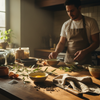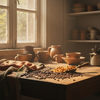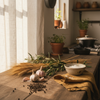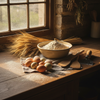Sautee Like a Pro: 5 Essential Techniques Explained
Ever watched your vegetables turn to mush in the pan when you were aiming for that perfect golden crisp? The secret isn't more heat or fancy ingredients—it's mastering the sautee technique. Sautéing (pronounced "saw-TAY") is the culinary equivalent of a perfectly timed dance move: quick, precise, and absolutely stunning when done right.
This French cooking method literally means "to jump," and once you understand why, you'll never approach your skillet the same way again.
Key Takeaways
- Sautéing is a French cooking method that means "to jump."
- The technique requires quick and precise movements to achieve the perfect result.
- Mastering sautéing prevents vegetables from becoming mushy and helps achieve a golden crisp.
- Success in sautéing relies more on technique than on heat or fancy ingredients.
- Understanding the sauté technique changes how you approach cooking with a skillet.
Table of Contents
- What Is Sautéing and Why Does It Matter?
- Essential Sautée Equipment and Setup
- Sautéed Vegetables: Your Gateway to Mastery
- The Step-by-Step Sautée Process
- Advanced Sautée Techniques: Professional Secrets
- Common Sautée Mistakes and Their Solutions
- Global Sautée Variations and Techniques
- Protein Sautée Mastery
- Essential Tools for Sautée Success
- Seasonal Sautée Ingredient Guide
- Troubleshooting Advanced Sautée Problems
- Building Flavor Profiles Through Sautée
- Scaling Sautée Techniques for Crowd Cooking
Think of sautéing as the difference between a confident chef and someone just hoping dinner turns out okay. It's not just cooking—it's controlled chaos that transforms ordinary ingredients into restaurant-quality dishes in minutes.
What Is Sautéing and Why Does It Matter?
Sautéing is a direct dry-heat cooking method that uses a small amount of oil or fat to cook food quickly over relatively high heat in a shallow pan. The magic happens through conduction—that direct contact between your heated pan and ingredients creates the golden exterior while preserving the tender interior. For a deeper dive into the basics and science behind sautéing, check out this comprehensive sautéing guide.
The technique originated from French culinary traditions, where efficiency met elegance. French chefs needed a method that could quickly brown ingredients while concentrating flavors and maintaining texture. The result? A cooking technique that's become essential in kitchens worldwide.
What sets sautéing apart from other cooking methods is the constant motion. Unlike pan-frying where food sits relatively still, or deep-frying where ingredients are submerged, sautéing keeps everything moving. This movement prevents burning, ensures even cooking, and creates that signature texture contrast—crispy outside, perfectly tender inside.
Sauté vs Fry: Understanding the Key Differences
Here's where many home cooks get confused. Frying uses significantly more oil and typically involves larger pieces of food that cook more slowly. Pan-frying might use a quarter-inch of oil, while sautéing uses just enough to coat the pan—usually one to two tablespoons.
The temperature difference matters too. Frying often happens at moderate temperatures for longer periods, while sautéing demands high heat for short bursts. Think of frying as a marathon and sautéing as a sprint.
Sautéing also differs from stir-frying, though they're cousins in the cooking family tree. Stir-frying typically uses even higher heat and happens in a wok, while sautéing works best in a wide, shallow pan with sloped sides.
Essential Sautée Equipment and Setup

Your pan choice can make or break your sautéing success. A heavy-bottomed skillet or sauté pan works best—something wide enough to hold ingredients in a single layer without overcrowding. Stainless steel and seasoned cast iron are ideal because they distribute heat evenly and can handle the high temperatures sautéing demands. To learn more about choosing the best utensils for your kitchen, see our guide on stainless steel kitchen utensils.
Size matters more than you might think. A 10 to 12-inch pan works perfectly for most home cooking situations. Too small, and you'll overcrowd your ingredients, causing them to steam instead of sauté. Too large, and your oil will spread too thin, creating hot spots that burn your food.
The right spatula makes all the difference in executing those signature "jumping" motions. You need something that can handle high heat without melting, won't scratch your pan, and gives you the control to keep ingredients moving smoothly.
Choosing the Right Oils and Fats
Not all cooking fats are created equal when it comes to sautéing. You need options with high smoke points—the temperature at which oil starts breaking down and creating unpleasant flavors and potentially harmful compounds.
Clarified butter is a classic choice because it has a higher smoke point than regular butter while maintaining that rich, nutty flavor. Rapeseed oil (canola oil) and sunflower oil are excellent neutral options that won't compete with your ingredients' natural flavors.
Avoid extra virgin olive oil for high-heat sautéing—save it for finishing dishes or lower-temperature cooking. Its low smoke point means it'll turn bitter and lose its beneficial properties when exposed to sautéing temperatures.
Sautéed Vegetables: Your Gateway to Mastery
Sautéed vegetables are where most home cooks either discover their confidence or lose it entirely. The key is understanding that different vegetables have different cooking times and moisture contents. Root vegetables like carrots need more time than delicate greens like spinach.
Start with vegetables that have similar cooking times, or add them to the pan in stages. Onions and bell peppers can go in together, but add tender vegetables like zucchini or mushrooms a few minutes later. This staging technique ensures everything finishes cooking at the same time.
Cut your vegetables into uniform pieces—this isn't just for presentation. Consistent sizing means consistent cooking times. A half-inch dice works well for most vegetables, maximizing surface area for browning while maintaining some texture.
Sautéed Potatoes: A Special Case
Sautéed potatoes require a slightly different approach because of their starch content and density. Start by parboiling them for 8-10 minutes until they're just beginning to soften. This pre-cooking step ensures they'll finish properly during the sautéing process without burning the exterior.
Pat your parboiled potatoes completely dry before they hit the hot oil. Any residual moisture will cause dangerous splattering and prevent proper browning. Let them develop a golden crust on one side before attempting to move them—patience here pays off with perfectly crispy results.
Season sautéed potatoes at the end of cooking. Salt added too early draws out moisture, working against the crispy texture you're trying to achieve.
The Step-by-Step Sautée Process
Successful sautéing follows a precise sequence that becomes second nature with practice. First, preheat your pan over medium-high to high heat. The pan must be hot before you add oil—this prevents sticking and ensures proper heat transfer.
Add your oil once the pan is heated. You'll know it's ready when the oil shimmers but doesn't smoke. If it's smoking, your heat is too high and you risk burning both the oil and your ingredients.
Add ingredients in a single layer without overcrowding. This is where many home cooks go wrong—too much food in the pan creates steam instead of the dry heat sautéing requires. Cook in batches if necessary.
Keep everything moving with frequent tossing or stirring. This constant motion is what gives sautéing its name and prevents burning while ensuring even cooking. The ingredients should literally "jump" in the pan as you toss them.
Most sautéing happens quickly—usually just a few minutes depending on your ingredients. You're looking for a golden exterior and the desired level of tenderness. Vegetables should be bright in color and still have some bite to them.
Season at the end for maximum flavor impact. Fresh herbs, a squeeze of lemon, or a final drizzle of good olive oil can elevate your sautéed dishes from good to extraordinary.
Mastering the sautée technique opens up a world of quick, flavorful cooking possibilities. Whether you're preparing sautéed vegetables as a side dish, sautéed potatoes for breakfast, or using this method as the foundation for more complex dishes, understanding these fundamentals sets you up for consistent success. The beauty of sautéing lies in its simplicity—high heat, constant motion, and quality ingredients working together to create something greater than the sum of their parts.
Advanced Sautée Techniques: Professional Secrets

Now that you've mastered the basics, let's dive into the techniques that separate weekend warriors from culinary artists. Professional chefs don't just sautee—they orchestrate a symphony of timing, temperature, and technique that transforms simple ingredients into memorable experiences.
The first professional secret is temperature control throughout the cooking process. Start with high heat to achieve initial browning, then adjust as needed. Dense vegetables might require a brief reduction in heat to cook through without burning, while delicate proteins need consistent high heat for proper searing.
Layering flavors during the sautee process creates depth that single-note cooking can't match. Start with aromatics like garlic, shallots, or ginger—but add them after your main ingredients have begun browning. These flavor builders cook quickly and can turn bitter if added too early.
Deglazing and Pan Sauce Mastery
Those beautiful brown bits stuck to your pan after sautéing aren't mistakes—they're liquid gold waiting to become an incredible pan sauce. Deglazing involves adding a small amount of liquid to dissolve these concentrated flavors, creating an instant sauce that elevates your entire dish.
Wine, stock, or even water works for deglazing, but the key is timing and temperature. Remove your sautéed ingredients first, then add liquid to the hot pan. The dramatic sizzle isn't just for show—it's the sound of concentrated flavors being released and incorporated into your sauce.
Scrape the bottom of the pan with your spatula while the liquid bubbles, incorporating all those caramelized bits. This technique, called "fond," is the foundation of countless professional sauces and gravies.
Multi-Stage Sautée Cooking
Professional kitchens often employ multi-stage sautéing for complex dishes. This means starting certain ingredients, removing them, cooking others, then combining everything for a final toss. This technique ensures each component reaches its optimal texture and flavor.
Consider sautéed vegetables with different cooking times: start onions and carrots, remove them when nearly done, sautee mushrooms until golden, then return the first vegetables for a final warming. Each ingredient maintains its distinct character while harmonizing with the others.
Common Sautée Mistakes and Their Solutions
Even experienced cooks fall into sautéing traps that turn promising dishes into disappointing meals. The most common mistake? Overcrowding the pan. When ingredients touch each other, they release moisture that creates steam, preventing the browning that makes sautéed dishes special.
Temperature inconsistency ranks as the second most frequent error. Starting with insufficient heat means your ingredients will release moisture before browning begins. Conversely, excessive heat burns the exterior before the interior cooks through, especially problematic with proteins and dense vegetables.
Moving ingredients too frequently or not enough both create problems. Constant stirring prevents proper browning, while neglecting to move food leads to uneven cooking and burning. Find the rhythm—let ingredients develop color, then toss, repeat.
Texture and Timing Troubleshooting
Mushy vegetables usually result from either overcooking or using ingredients with too much moisture. Pat vegetables dry before cooking, and remember that residual heat continues cooking even after removing the pan from heat. Slightly undercook, then let carryover heat finish the job.
Tough proteins in sautéed dishes often indicate insufficient heat or overcrowding. Proteins need high heat to develop proper texture quickly. If your pan isn't hot enough, proteins cook slowly and become chewy instead of tender.
Global Sautée Variations and Techniques
While sautéing originated in French kitchens, cultures worldwide have developed their own interpretations of quick, high-heat cooking with minimal fat. Understanding these variations expands your technique repertoire and flavor possibilities. If you want to explore more culinary techniques from around the globe, visit this culinary techniques resource.
Chinese stir-frying shares DNA with sautéing but employs even higher heat and constant motion in a wok. The curved shape allows ingredients to move up the cooler sides when they need gentler heat, while the bottom provides intense searing power.
Italian "soffritto" begins many dishes with sautéed aromatics—onions, carrots, and celery cooked slowly until softened and fragrant. This technique builds flavor foundations rather than creating finished dishes, showing how sautéing serves different culinary purposes.
Healthy Sautée Alternatives
Health-conscious cooks can modify traditional sautéing techniques without sacrificing flavor. Water sautéing uses small amounts of broth, wine, or even water instead of oil, relying on the pan's heat and ingredient movement for cooking. For more insights into healthy sautee methods, see the American Heart Association's healthy sauteing recommendations.
This technique works particularly well for vegetables with natural moisture content. Start with a tablespoon of liquid, add vegetables, and toss frequently. Add more liquid only if needed to prevent sticking. The result lacks the rich mouthfeel of oil-based sautéing but maintains the quick cooking and concentrated flavors.
Protein Sautée Mastery

Sautéing proteins requires different considerations than vegetables. Thin cuts of meat, fish fillets, and shellfish work best because they cook quickly and evenly. Thick proteins need different techniques or preliminary cooking to avoid burning the exterior before the interior reaches safe temperatures.
Pat proteins completely dry before sautéing—moisture is the enemy of proper browning. Season just before cooking to prevent drawing out moisture, and don't move proteins until they've developed proper color on the first side.
Chicken cutlets, fish fillets, and shrimp showcase sautéing's ability to create restaurant-quality proteins at home. The key is matching protein thickness to cooking time—pound chicken to even thickness, choose fish fillets of consistent size, and size shrimp uniformly.
Finishing Touches and Presentation
Professional presentation begins during cooking, not after plating. Keep sautéed ingredients moving to prevent breaking apart, and remove them from heat while they still maintain their shape and color integrity.
Fresh herbs added at the last moment provide color contrast and bright flavor notes that complement the rich, concentrated flavors developed during sautéing. A squeeze of fresh lemon juice or splash of good vinegar brightens heavy dishes and balances richness.
Temperature contrast adds another dimension to sautéed dishes. Serve hot sautéed vegetables over cool greens, or top room-temperature grains with warm sautéed proteins. These contrasts create more interesting eating experiences than uniform temperatures throughout.
Mastering these advanced sautée techniques transforms this fundamental cooking method from basic necessity to creative expression. Whether you're preparing simple sautéed vegetables for weeknight dinners or complex multi-component dishes for special occasions, these professional approaches ensure consistent, impressive results that showcase both your ingredients and your growing culinary skills.
Essential Tools for Sautée Success
Your sautéing success depends heavily on having the right tools in your arsenal. The pan makes the biggest difference—choose a heavy-bottomed stainless steel or well-seasoned cast iron skillet that distributes heat evenly. Thin, lightweight pans create hot spots that burn ingredients before they properly cook through.
Size matters more than you might think. A 10-12 inch pan works best for most home cooking scenarios, providing enough surface area to avoid overcrowding while remaining manageable on standard stovetops. Too small, and you're forced into multiple batches; too large, and heat distribution becomes uneven.
Your spatula choice can make or break the entire process. DI ORO's award-winning seamless spatulas handle the high heat and constant motion that sautéing demands. Heat-resistant to 600°F and made with pro-grade, forever-chemical-free silicone, they won't melt, warp, or release toxins when temperatures climb during intense sautéing sessions. For those seeking a reliable upgrade, consider the Seamless 4-Piece MODA Turner Set for pro-quality results.
Why Forever-Chemical-Free Matters in High-Heat Cooking
When you sautee at high temperatures, inferior tools can release harmful chemicals directly into your food. Traditional plastic utensils break down under heat, while low-quality silicone may contain forever chemicals that leach into your carefully prepared ingredients.
DI ORO's pro-grade silicone construction means you can confidently toss, flip, and scrape without worrying about what's transferring from your tools to your plate. America's Test Kitchen recognized our spatulas as the most versatile on the market because they perform flawlessly under the demanding conditions that sautéing requires.
Seasonal Sautée Ingredient Guide
Understanding which ingredients sautee best during different seasons elevates your cooking from good to extraordinary. Spring brings tender vegetables like asparagus, peas, and baby carrots that need minimal cooking time and gentle handling to preserve their delicate flavors and crisp textures.
Summer's abundance offers perfect sautéing opportunities with zucchini, bell peppers, and fresh corn. These ingredients contain more moisture than their winter counterparts, so higher heat and quick cooking prevent them from becoming waterlogged and mushy.
Fall and winter vegetables like Brussels sprouts, cauliflower, and root vegetables require different sautéing approaches. Their denser structure benefits from slightly lower heat and longer cooking times, sometimes requiring a splash of liquid and brief covering to steam-finish after initial browning.
Protein and Seasonal Pairings
Seasonal cooking extends beyond vegetables to include proteins that complement the time of year. Light fish and seafood pair beautifully with spring vegetables, while heartier proteins like chicken thighs and pork work better with robust fall flavors.
The sauté vs fry distinction becomes important here—sautéing's lighter touch preserves seasonal ingredients' natural characteristics, while frying's heavier hand can overwhelm delicate spring flavors but complements winter's heartier fare. For more inspiration on different cooking methods, explore our braising recipes collection.
Troubleshooting Advanced Sautée Problems

Even experienced cooks encounter sautéing challenges that seem mysterious until you understand the science behind them. Ingredients that stick despite adequate oil usually indicate insufficient preheating—the pan needs to be hot enough that a drop of water immediately sizzles and evaporates.
Uneven browning often results from ingredient size inconsistencies rather than technique problems. Take the extra time to cut everything uniformly; it's the difference between professional-looking results and amateur hour.
When sautéed potatoes turn gummy instead of crispy, excess starch is the culprit. Rinse cut potatoes in cold water, then pat completely dry before cooking. This simple step removes surface starch that prevents proper browning and creates the gluey texture that ruins the dish.
Altitude and Humidity Adjustments
High-altitude cooking affects sautéing more than most people realize. Lower air pressure means moisture evaporates faster, requiring slight temperature reductions and more frequent liquid additions to prevent burning.
Humid climates create the opposite problem—excess moisture in the air affects ingredient surfaces, making initial browning more challenging. Combat this by patting ingredients extra dry and ensuring your pan reaches full temperature before adding any food.
Building Flavor Profiles Through Sautée
Advanced sautéing involves understanding how different cooking stages build layered flavors. The saute meaning in cooking extends beyond simple browning to include developing complex taste profiles through careful ingredient timing and temperature management. To further enhance your sautee experience, consider equipping your kitchen with tools from our Seamless Series collection.
Aromatics like garlic, ginger, and shallots release different flavor compounds at different temperatures. Add them too early, and they burn; too late, and they remain harsh and raw. The sweet spot comes after your main ingredients have released some moisture but before they finish cooking.
Spices benefit from brief sautéing to bloom their flavors, but they need even more careful timing than fresh aromatics. Whole spices can handle more heat and longer cooking, while ground spices need just seconds of contact with hot oil before burning turns them bitter.
Acid Balance and Finishing Techniques
The final moments of sautéing offer opportunities to balance and brighten flavors through acid additions. A splash of wine, vinegar, or citrus juice deglazes the pan while adding complexity that transforms simple sautéed ingredients into restaurant-quality dishes.
Timing these additions requires understanding how acids behave under heat. Wine needs time to cook off its harsh alcohol notes, while delicate citrus juices should be added off the heat to preserve their bright character.
Fresh herbs represent the final layer of flavor building. Hardy herbs like rosemary and thyme can withstand brief sautéing, while delicate herbs like basil and parsley should be stirred in after removing the pan from heat to prevent wilting and flavor loss.
Scaling Sautée Techniques for Crowd Cooking
Cooking for larger groups can compromise sautéing quality due to overcrowding, which hinders proper browning. Professional kitchens avoid this by batch cooking—preparing ingredients in stages and combining them at the end. Home cooks can apply the same method: sauté in smaller batches and keep finished portions warm in a low oven. This preserves the high heat and caramelization that define great sautéing. For tool efficiency, check out our guide on cooking tongs.
When scaling up, it’s also helpful to compare sautéing vs. stir frying. Stir frying uses intense heat and constant motion, ideal for larger quantities, while sautéing suits smaller, more precise batches. Even understanding how to pronounce "sauté" (“soh-TAY”) reflects culinary awareness. Whether you’re making simple sautéed vegetables or elegant potatoes, mastering these methods and using high-quality tools can turn this basic technique into a go-to strategy for crowd-pleasing, flavorful meals.
Frequently Asked Questions
Why is it called sautee?
The term 'sauté' comes from the French word meaning 'to jump,' which perfectly describes the quick tossing motion used when cooking food in a hot pan. This technique causes the ingredients to literally jump or bounce as they cook, ensuring they cook evenly and develop a deliciously browned exterior.
What is a sauté in cooking?
Sautéing is a cooking method that involves cooking food quickly in a small amount of oil or fat over relatively high heat. The goal is to brown the food while preserving its texture, moisture, and flavor, making it perfect for vegetables, meats, and seafood alike.
What are examples of sautee?
Classic examples of sautéed dishes include garlic and mushrooms, stir-fried vegetables, seared chicken breasts, and shrimp scampi. Essentially, any ingredient that benefits from fast, high-heat cooking to develop flavor and texture can be sautéed.
What is a synonym for sautee?
A common synonym for sauté is 'pan-fry,' though sautéing typically uses higher heat and less oil than traditional frying. Other similar cooking techniques include stir-frying and searing, all involving quick, hot cooking in a pan.
Is it sauté or sautee?
The correct spelling is 'sauté,' with an accent over the 'e,' reflecting its French origin. While 'sautee' is sometimes used informally, sticking with 'sauté' is best for clarity and authenticity.
Is sautéing healthy?
Sautéing can be a healthy cooking method when using minimal, quality oils like olive oil and cooking nutrient-rich ingredients like vegetables and lean proteins. Because it cooks food quickly and preserves nutrients better than longer cooking methods, it’s a great choice for health-conscious home chefs.



